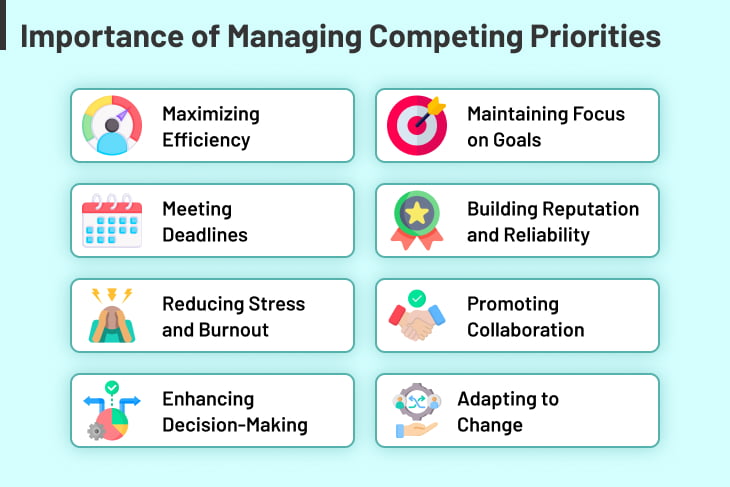Importance of managing competing priorities

- Maximizing Efficiency: Efficiently managing competing priorities allows individuals to optimize their time and resources.
- Meeting Deadlines: Many roles come with tight deadlines and time-sensitive projects. Effective priority management ensures that critical tasks are identified and addressed promptly, reducing the risk of missed deadlines and project delays.
- Reducing Stress and Burnout: By managing priorities, individuals can create a structured approach to their work, reducing the overwhelming feeling associated with an unorganized workload.
- Enhancing Decision-Making: Prioritization involves making decisions about which tasks are most important and require immediate attention.
- Maintaining Focus on Goals: By staying focused on what truly matters, professionals can make consistent progress toward their objectives, avoiding the trap of getting bogged down by less critical tasks.
- Building Reputation and Reliability: Successfully managing competing priorities showcases an individual’s ability to handle complex situations and deliver results.
- Promoting Collaboration: Prioritization often involves collaboration and communication, especially in team settings.
- Adapting to Change: Those skilled in managing competing priorities demonstrate an ability to adapt to changing circumstances, making them valuable assets in dynamic organizations.
Best Techniques for Managing Competing Priorities
Task management tools
Task management tools play a crucial role in managing priorities by providing a structured and organized approach to handling tasks. Tools like Alian Hub provide a centralized location to store and organize all your tasks. This makes it easier to have a comprehensive view of your workload and competing priorities.
Collaboration features in task management tools facilitate communication among team members. When managing competing priorities within a team, these tools enable effective communication, coordination, and sharing of updates, ensuring everyone is on the same page.
Create clear goals
When you establish specific objectives and KPIs, organizing your priorities becomes simple. These important markings act as a road map, assisting you in determining which tasks require immediate attention and which ones can wait. Setting up your objectives for effective tracking is just as simple.
Make folders to keep track of employee work, and sprint cycles. These folders may also be used to organize similar goals so you can quickly see what has been finished and what is still waiting. With the timesheets feature of Alian Hub, you can easily track your project goals and achieve them.
Rate the priorities
Set the level of each priority as low, medium, or high. Follow the high-to-low priority hierarchy and manage the tasks. Thus, you can complete your tasks and deliver them on time.
Plan resource allocation
When allocating tasks to team members, knowing what is more important enables more effective use of scarce resources. Think about an instance within a development team. Think about an instance within a software development team. You are working on three separate tasks at the moment: a high-budget client project, a start-up project with the possibility for long-term partnerships, and a short-term, low-budget task. In such situations, you need to allocate resources in a way that becomes beneficial to the company and clients.
Communicate
Keep the stakeholders informed and in the loop of the project’s progress. Furthermore, have clear communication with your team members to understand the priority work and the tasks that take more time.
Conclusion
Having the ability to navigate the complexities of competing priorities is essential in the fast-paced work environment of today. Task management and prioritization skills may set a person apart and help them not only meet but stand beyond expectations. Adopting a strategic approach may result in higher output, lower stress levels, and greater professional success.

